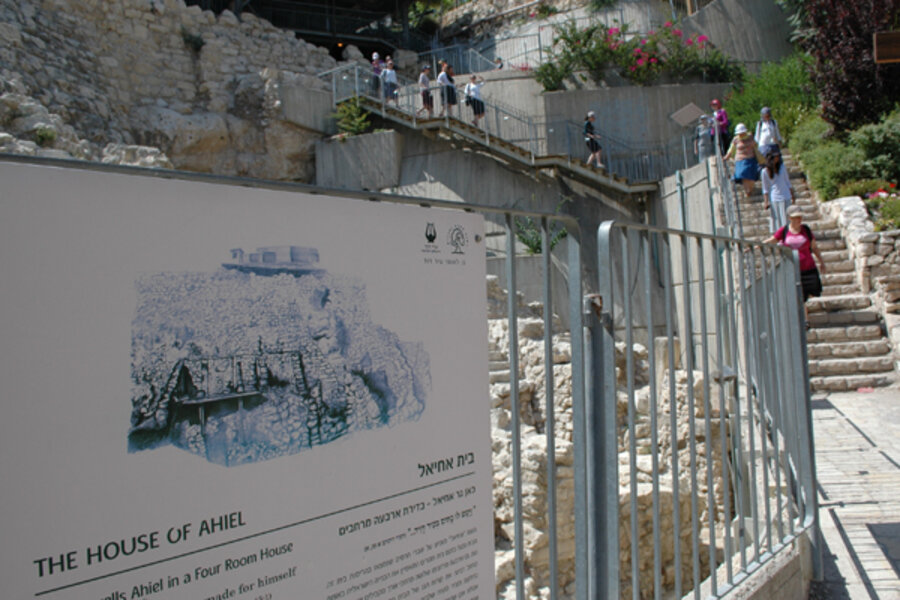In Jerusalem, the politics of digging up the past
Loading...
| Jerusalem
As the heart of Judaism, the setting of Jesus' crucifixion and resurrection, and the third holiest site in Islam, Jerusalem is home to many colliding interests – including anything involving dirt.
While the debate over the extent of King David's realm has focused heavily on Khirbet Qeiyafa to the southwest, archaeological work in Jerusalem also offers evidence about David and the biblical record – but in an even more fraught environment. Gabriel Barkay, who has worked as an archaeologist in the city for decades, says that even moving a single "grain of dirt from one place to another is political."
"It is a boiling caldron, the stew of which is stirred up by so many spoons," says Dr. Barkay. He cites the Chief Rabbinate of Israel (the supreme spiritual authority for Jewish people in the country), the Greek Orthodox Patriarchate, UNESCO, the city of Jerusalem, the Israeli Antiquities Authority, the Ministry of Foreign Affairs, the Ministry of Religious Affairs, and the Vatican.
"The Temple Mount is the soul, heart, and spirit of Jewish history ... [and of events] in Islamic periods, also in medieval periods, and up to our day," says Barkay. "It is a focal point in the understanding of what goes on here. And the Temple Mount is a black hole in the archaeology of Jerusalem. It was never, ever excavated."
So it's perhaps not surprising that he fought a prolonged battle to reclaim hundreds of truckloads of dirt that he calls "saturated with the history of Jerusalem." In 1999, Palestinians began removing the material from the Muslim-controlled Temple Mount, or Haram al-Sharif, and dumping it in the Kidron Valley at night.
The Palestinians said they were simply trying to build an emergency exit at a mosque. But the dirt included material that archaeologists determined was from the First and Second Temple periods, vital to Jewish history, and the project expanded beyond what Israeli authorities were expecting. Five years later, Barkay managed to reclaim it and established the Temple Mount Sifting Project to find artifacts among the rubble.
Palestinian leaders have increasingly refrained from acknowledging the existence of a Jewish temple in Jerusalem – and some outright deny it. Meanwhile, those seeking to shore up the Jewish nation's ties to the city have largely ignored the legacy of centuries of Muslim presence as well as that of early ethnic groups such as the Canaanites, believed by some to be the ancestors of Palestinians.
"The stakes, in political terms, are very high," says Eric Meyers, a religion professor at Duke University in Durham, N.C. "You have a huge misuse of archaeology by both sides to prove their narrative is more true than others and to justify facts on the ground."
One site that embodies many of the political sensitivities lies just over the towering Old City wall that encompasses the Temple Mount. Here, along a narrow ridge, some archaeologists believe King David established a smaller Jerusalem as the capital of ancient Israel.
Until relatively recently, few Jews dared to come to the area, a predominately Arab neighborhood known as Silwan. But in 1986, an organization called the Ir David Foundation began a make-over and created the City of David archaeological park, which today attracts half a million visitors a year.
As harp music filters through the air, visitors meander past the foundation of a large building that archaeologist Eilat Mazar claims is David's palace – another piece of supporting evidence for a regional kingdom with a powerful central authority (though others refute this). Thus the City of David reinforces the idea that Jews have a 3,000-year-old connection to their "eternal and undivided capital," including East Jerusalem, which Israel recaptured in the 1967 war with its Arab neighbors.
"I think it's quite obvious that the government and the Israeli people should want the archaeology to be discovered, especially ... in the City of David, which is the heart of the Jewish story, where everything really started," says Oriya Dasberg of Ir David. "This is the way to tell the story of the nation."
Arabs living in the area, however, have become virtually encircled by the maze of paths, projects, and underground tunnels that cater largely to Jews. So Ir David, which also promotes Jewish settlement in predominantly Arab neighborhoods of East Jerusalem, has drawn criticism for politicizing archaeology and minimizing Palestinian claims to the city as the capital of a future Palestinian state.
"They have a political agenda, so what?" says Barkay, whose Temple Mount Sifting Project is also funded by Ir David, noting that the group has never told him what to find or report.
But some see the intense focus on the past as detracting from the present – part of a broader misuse of archaeology, whether for political or cultural ends, or as a prop for religious faith.
"When people see this place as the City of David and not as Silwan, they're deleting the present," says Yonathan Mizrachi, founder of Emek Shaveh, a nonprofit that gives alternative archaeological tours of the area. If the tourism is an attempt to legitimize Jewish settlement in a sensitive area of East Jerusalem, in part by establishing a historical link, it is unnecessary, he says.
"I don't think we need archaeology to legitimize Israel, or the need of Israel," says Mr. Mizrachi. "You don't need to find David's palace or city, or Solomon's temple, to legitimize our rights here."
"I think people are putting too much on the shoulders of archaeology," he adds – in religion as well as politics. "Science should try to provide answers, but it can't provide the answers to all our questions, and it should not replace religion.... You don't need physical proof for your beliefs."







